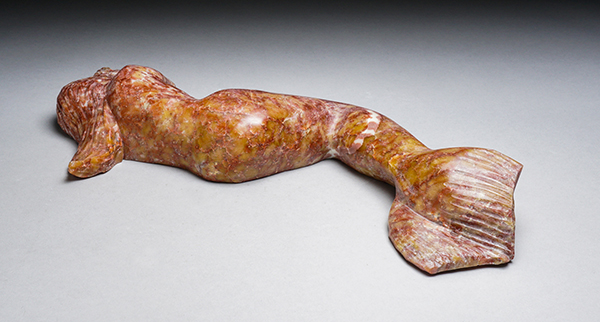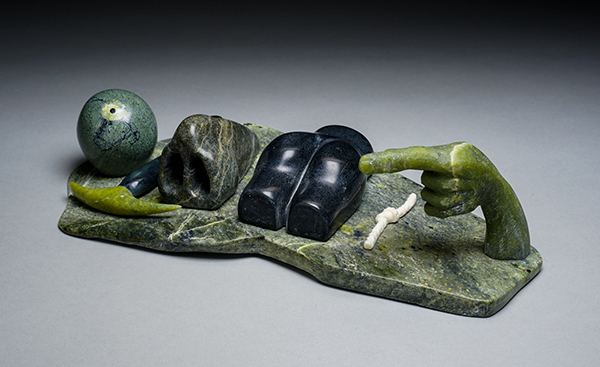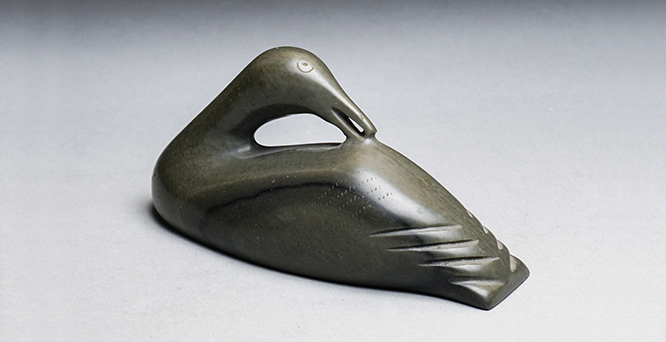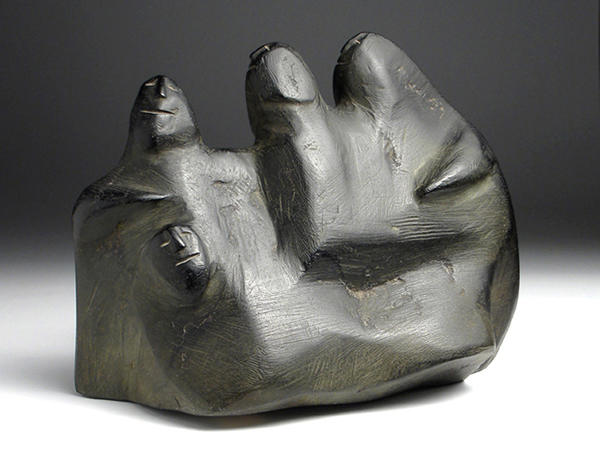“What type of stone is this?” is one of the most common questions we receive about sculptures, and it’s a good one. While many think of Inuit sculpture as synonymous with “soapstone” (the name given to a specific type of soft stone), artists across the Arctic in fact use a variety of local stone types that are available in their community, and a lot of it certainly isn’t soft! The natural state of the stone is incredibly important for artists. Master sculptors Pauta Saila and Oviloo Tunnillie, for example, have cited that the hardness and shape of the stone had an influence on guiding their hand and creative vision:
“I make one particular carving now though with different motions, the Dancing Bear. I carve them the way the stone suggests.” —Pauta Saila, 1993 [1]
“It can be very difficult to sculpt the idea that you have in your mind. If your idea doesn’t match the shape of the stone your idea may have to change because you have to accept what is available in the rock.” —Oviloo Tunnillie, 1999 [2]
Not only does the hardness and shape of the stone vary from region to region, but so does its colour, weight, and its ability to be polished. These characteristics vary according to what has been quarried locally and sometimes shipped in from other communities. Here’s a brief breakdown of four types of stone commonly used in Inuit sculpture, where they come from, and how they work:
-
Soapstone (or steatite)

Bill Nasogaluak, Sedna, 2014, Brazilian soapstone, 12 x 5 x 1 3/4 in.
- A soft metamorphic stone used by Inuit for thousands of years, most notably to make qulliq (oil lamps).
- Found throughout the Arctic and introduced to Kinngait as an art-making medium in the 1950s by government advisor James Houston.
- Arctic soapstone is a dark grey stone that contains a high concentration of the mineral talc which many artists now find too soft to sculpt. [3]
- “Soapstone” is sometimes used as an umbrella term to describe all carving stone used by Inuit artists, however not all sculpture made by Inuit artists is made from soapstone!
- Southern-based artists like Bill Nasogaluak and Jonasie Faber procure their soapstone elsewhere, giving them access to soapstone varieties from across the continent including Brazilian soapstone which comes in various colours.
-
Serpentinite (or serpentine)

Jamasie Pitseolak, HOW TO READ “EYE PICK NOSE BUTT KNOT YOU,” 2019, various serpentinites, 10 ½ x 6 x 2 ½ in.
- A semi-soft metamorphic rock that gives sculptors the freedom to explore naturalistic forms and complex compositions, sometimes with intricate details.
- Found throughout the Arctic and seen most prominently in works by artists from Kinngait, Kimmirut, Iqaluit, Gjoa Haven, and Taloyoak.
- It’s not always green! Serpentinite can also be black, brown, or a mottled mixture of all three.
- Serpentine is the name of the mineral found within serpentinite rock and usually comprises most of the rock’s volume. Sometimes the two terms are used interchangeably, however most “serpentine” sculptures are in fact a mix of various minerals.
- It can be highly polished which often reveals a beautiful lustre and transparency inherent in the stone.
-
Argillite

Catherine Amak Manik, Loon, n.d. Sanikiluaq argillite, 1 2/4 x 4 1/2 x 1 1/4 in.
- A sedimentary rock found throughout Canada, from Haida Gwaii to Nunavik (Arctic Quebec).
- Amongst Inuit artists, it is used predominantly by Nunavik sculptors.
- It is often a dark grey colour that, when etched or filed, leaves behind white markings. This lends itself well to artists who prefer to inscribe texture or images onto their sculpture.
- A unique, milky-green coloured argillite is local to the community of Sanikiluaq. This stone can be polished to a satin-like semi-gloss finish.
-
Basalt

Lucy Tasseor Tutsweetok, FOUR FIGURES, 1971, basalt, 6 x 4 x 8 in.
- A very hard and heavy igneous rock.
- Used by artists from Arviat, Qamani’tuaq, and Rankin Inlet.
- Darkly coloured.
- Its high density makes it very heavy and tough to carve. Artists like Lucy Tasseor Tutsweetok, Barnabas Arnasuungaaq, and Tuna Iquliq worked in this type of stone which lent to a minimalist style that veered toward abstraction.
Sources:
[1] Eber, Dorothy. “Talking with the Artists,” in The Shadow of the Sun: Perspectives on Contemporary Inuit Art (Gatineau: Canadian Museum of Civilization, 1993), 435. [2] Feheley, Patricia. Dorset Magic: Four Decades of Sculpture from Cape Dorset (Toronto: Feheley Fine Arts, 1999), n.p. [3] Coward Wight, Darlene. Oviloo Tunnillie: Life & Work (Toronto: Art Canada Institute, 2019), https://aci-iac.ca/art-books/oviloo-tunnillie/style-and-technique/#materials.Gustavison, Susan et al. Northern Rock: Contemporary Inuit Stone Sculpture (Kleinburg, ON: McMichael Canadian Art Collection, 1999).
